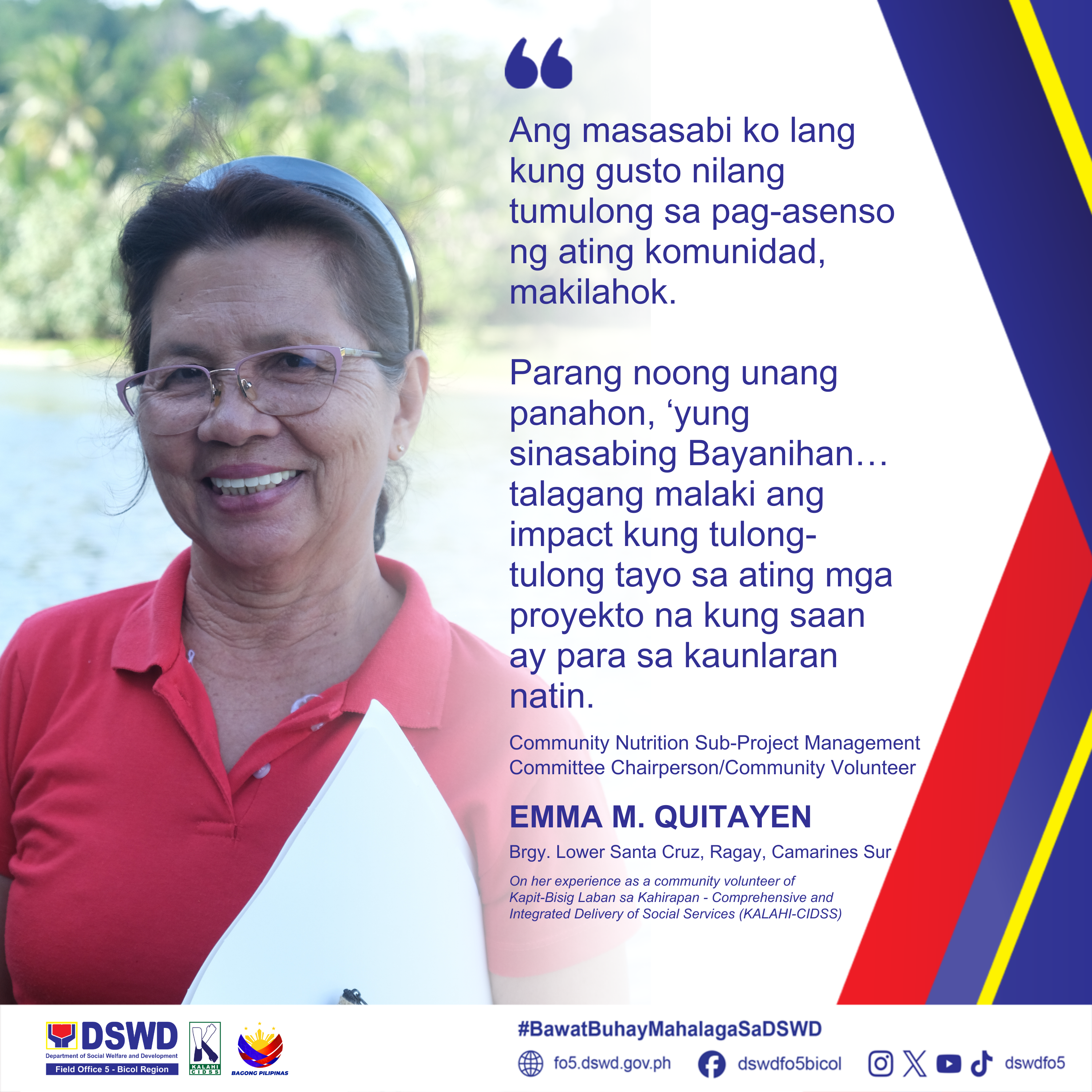
Disasters, particularly natural phenomena, are inevitable. Our country, the Philippines, is one of those prone to typhoons due to its location in the Pacific Ring of Fire and exposure to the Pacific Ocean. Most often, those in low-lying areas are hardest hit. Like many other parts of the country, Ragay, Camarines Sur, is vulnerable due to its location, especially Barangay Lower Sta. Cruz.
“Ang pangunahin namin ditong nagiging problema pag panahon ng tag-ulan, pag may bagyo ‘yung baha pumapasok dito, hanggang dito sa may barangay hall napasok ang ulan. Dito naman sa tabing ilog, ‘yung mga naninirahan diyan siyempre na-evacuate sila pag-panahon ng may kalamidad para makaiwas sa baha… at sa landslide,” said Dely Cardenas, 66-year-old Barangay Chairperson of Lower Sta. Cruz, Ragay, Camarines Sur.
(During the rainy season and typhoons, floods reach up to the barangay hall. Those residing near the riverside are evacuated during calamities to avoid floods and landslides.)
During typhoons and floods, many residents in the barangay are severely affected and forced to evacuate. Emma Quitayen, fortunate with a better located home, opens it as a temporary shelter for evacuees until the calamity passes.
Witnessing the difficulties faced by most residents, especially those near the riverside, Emma sought ways to help beyond providing shelter. This led her to volunteer with the Department of Social Welfare and Development’s (DSWD) Kapit-Bisig Laban sa Kahirapan – Comprehensive and Integrated Delivery of Social Services (KALAHI-CIDSS).
“Ang nag-udyok sa akin, kauna-unahan po niyan ay makatulong para sa barangay, as a resident. At saka noong mga panahon na nagkakaroon ng typhoon and other calamities na involved ay ang flooding, ‘yung bahay ko’y naging…kanlungan nila, noong habang sila ay mayroong takot na baka sila ay maapektuhan ng baha,” Emma shared.
(My primary motivation was to help the barangay as a resident. During typhoons and floods, my house became their refuge when they feared flooding.)
As Emma began volunteering, the first sub-project in their barangay was River Bank Protection, crucial for residents. During implementation, they faced challenges, particularly adverse weather conditions, causing delays.
“Ang kauna-unahan na narasan (na pagsubok) ‘yung weather condition…dahil pag katulad nga…masyadong (mataas) yung baha. So, ‘yun ang naging problema sa amin. Na-challenge sa amin habang kami ay nag-iimplement ng aming River Bank Protection,” the volunteer recounted.
(Our first challenge was the weather, especially when flooding was severe. This posed a problem as we implemented River Bank Protection.)
Challenges are natural and inevitable. Emma views them positively, seeing them as opportunities for personal growth and community benefit. Handling these challenges honed her leadership skills and taught her conflict resolution. More importantly, they empowered her as a community volunteer.
“Sa mga problemang nadaanan namin, so, ang unang-una siyempre isasangguni ko sa mga kasamahan ko. Magkakaroon kami ngmeetings kung papano namin mabibigyan ng solusyon yung mga problema. So, luckily naman sa tulong ng council, nareresolbahan namin ang mga problemang na-eencounter namin,” she said.
(Facing challenges, I consult my fellow volunteers first. We hold meetings to find solutions. With council support, we resolve encountered problems.)
Like in other communities, KALAHI-CIDSS aided their barangay residents. Emma noted that beyond volunteers, other residents learned to identify problems and participate in necessary interventions for sub-project implementation.
“Ang nagiging epekto para sa komunidad ay natututo na rin sila na maglabas ng kanilang saloobin. Kung ano yung kailangan ng isang zone na dapat i-address, bigyan ng tulong na galing sa mga agencies,” she stated.
(The community is learning to express their needs and seek assistance from agencies.)
KALAHI-CIDSS made a significant impact, evident in achieving its objectives. Sub-projects like River Bank Protection improved community conditions, providing security during calamities.
“Noong dumating ang KALAHI (-CIDSS) siyempre ang unang-una, River Bank Protection. Nawala na yung kanilang takot na baka madala yung bahay nila and yung mga anak nila na malunod,” she said.
(When KALAHI-CIDSS arrived, River Bank Protection was first. It eased fears of homes being washed away and children drowning.)
Emma personally witnessed KALAHI-CIDSS’ positive changes in the community, stressing the importance of community-wide participation for development.
“Ang masasabi ko lang kung gusto nilang tumulong sa pag-asenso ng ating komunidad, makilahok. Parang noong unang panahon, ‘yung sinasabing Bayanihan…talagang malaki ang impact kung tulong-tulong tayo sa ating mga proyekto na kung saan ay para sa kaunlaran natin,” Emma firmly said.
(To contribute to community progress, get involved. It’s like the Bayanihan spirit of old—the impact is significant when we collaborate on projects for our advancement.)
Written by: Alexandra H. Burce, Administrative Officer II
Edited by: Marygizelle B. Mesa, Regional Information Officer
